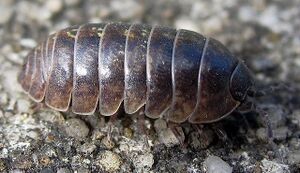Armadillidium vulgare
Also commonly referred to as the Common Pill bug, Sowbugs (even though this is an incorrect classification), Roly-Polies and even Wood Lice. They are members of the Isopods, not to be confused with an insect[1]. They belong to the family Armadillidiidae and are found almost everywhere and are soil/ground dwelling isopods. These isopods can easily be spotted, as they roll into a ball to protect themselves. Pill bugs can reach over 10,000 individuals per square meter which converts to 900 individuals per square foot[2]. There are 4,000 different species of Armadillidium vulgare and are none are considered dangerous. Pill bugs do not bite, sting, or carry any diseases. They do not lay their eggs indoors. However, they may damage the roots of plants when feeding[3].
Taxonomy
Kingdom: Animalia
Subphylum: Crustacea
Class: Malacostraca
Order: Isopoda
Family: Armadillidiidae
Genus: Armadillidium
Species: vulgaris

Description
Pill bugs have a type of hard armor/shell, that is similar to that of an armadillo. This hard armor is used to protect the isopod from any danger. It is plate like and allows for a quick and full protection when they roll into the ball. These little guys are between 1/4 and 5/8 inches long and have seven pairs of legs and 2 pairs of antennae. They are most commonly found to be a light grey, but also have been seen in many colors. Some examples being brown, black, yellow and on rare occasions a deep red color[4]. They are special in the fact they have an extreme patience when their threatened, spending hours inside of their ball until they feel safe to emerge[1]. On the scale of speed they are considered slow movers, which is why they are so defensive with their outer shell.
Habitat
Found all over the world, Pill bugs are quite lenient with this habitat choice. Usually found within the ground and leaf litter, they cant find their homes below any type of forest or grass soil. They feed on roots while underground, which is the only time they are considered harmful. Flip over any type of rock or fallen tree and you'll more than likely find tons of Pill bugs. They require a humid and dark habitat and are mainly nocturnal animals[5].